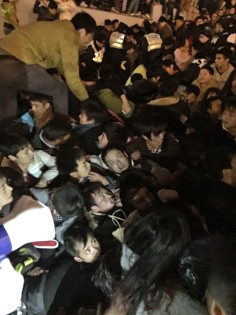Four Shanghai officials to be sacked over New Year stampede that killed 36
Investigators hold lower-level bureaucrats largely responsible for loss of 36 lives on New Year's Eve, with municipality escaping censure

Blame for the deaths of 36 people in Shanghai on New Year's Eve was placed squarely on the shoulders of Huangpu district officials yesterday when the city government released the results of its investigation into the deadly stampede.
But state media and the victims' families questioned why the municipal authorities escaped responsibility for what was one of the worst tragedies of its kind in China in recent years.
The investigation report also revealed that 771 police and 180 security guards were initially deployed for the new year event. Of those, 350 police officers were sent to controls crowds at the riverside attraction and the main thoroughfare, Nanjing Road. The rest had other responsibilities such as counterterrorism and logistics. People's Daily said 100 officers from the People's Armed Police were also at the scene monitoring the crowd.
Watch: China sacks four officials over Shanghai stampede
The authorities deployed the particularly thin blue line despite the presence of 120,000 people along the Bund by 8pm. By around 11pm, before the stampede, the crowds had swelled to 310,000.
At ground zero in Chen Yi Square, there were just 60 officers, of whom only seven were stationed on the staircase where 36 people were killed and 49 injured, the investigation report said.
It named the Huangpu district government, district police and the district's tourism authorities as responsible for the tragedy, laying a lower level of blame for failures in "supervision responsibility" at the feet of Shanghai municipal police.
Huangpu Communist Party chief Zhou Wei, district governor Peng Song , police chief Zhou Zheng and deputy police chief Chen Qi were sacked for failing to precisely assess risks, adequately communicate with the public, effectively prepare for the crowds and carefully monitor the situation, the report said.
Another seven officials, including a deputy district chief of Huangpu, were given administrative punishments.
Investigators also accused the district authorities of failing to inform the public that there was no countdown event in the area where the stampede took place.
In a question-and-answer interview with investigators, state mouthpiece People's Daily asked why no municipal officials were held responsible.
A municipal official said only that the law stipulated that direct responsibility lay with the district government.
A Xinhua reporter raised the same question and failed to get an answer at a press conference yesterday in which the municipal government announced the investigation's findings.
Li Qi, a cousin of 25-year-old Li Xiang who died in the stampede, said it was not fair to punish only Huangpu district and its officials. "The verdict failed to do justice to the victims," Li Qi said.

Police sources also told the South China Morning Post that the city's public security bureau usually took charge of crowd control, coordinating with other authorities and lower-level governments.
It was the first time that Huangpu district was assigned the job to oversee the New Year's Eve crowd, they said.
"The city government had no excuse for the improper deployment of police and the sloppiness," the source said.
But local government sources said the municipal government might not be able to get away easily, especially after Vice-Premier Ma Kai said earlier that the stampede had inflicted "extremely woeful" social damage.
Zhou Wei was a protégé of Shanghai party secretary Han Zheng .
A big reshuffle among mid-level officials in the district would take place soon and affect dozens of people, sources said.
Government measures to avoid similar incident:
- Improve safety awareness of public and officials
- Beef up management of places or events with big crowds
- Improve monitoring of large crowds and government's ability to control such crowds
- Strengthen government departmental cooperation to help cope with emergencies
- Implement education campaign on public safety
- Publish alerts on big screens at public venues, local media and social-media platforms
- Broadcast safety messages on radio stations and loudspeakers
- Share alerts between relevant government departments
- Strengthen analysis of crowds, spot signs of possible trouble and activate timely emergency preparation plans
- Impose traffic restrictions and pay special attention to staircases linking areas
- Scenic spots must assess maximum vistor numbers and prepare a plan to control the flow of visitors
- Safety inspections by the end of June at public venues across the city, such as tourist spots, commercial areas, sports venues, entertainment centres, schools, parks, subway stations, airports, and ports
- List all safety risks at these places; investigate measures to rectify any existing problems